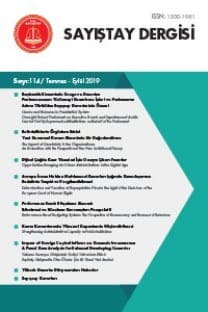DENETİMDE KALİTENİN SAĞLANMASINDA ÜST YÖNETİMİN YAKLAŞIMI VE SAYIŞTAYIN DENEYİMLERİ
Son yıllarda kamu sektöründe iyi yönetimin sağlanmasına yönelik Yüksek Denetim Kurumlarına YDK verilen görev ve sorumluluklar artmaktadır. Bu durum YDK’ların şeffaf ve hesap verebilir şekilde faaliyet göstermeleri gerekliliğini ortaya çıkarmıştır. YDK’lar faaliyetlerine yönelik olarak hesap verebilir olmak için paydaşlarının güvenini kazanmak zorundadır. Paydaşların güveninin kazanılması ise kaliteli çıktılar üretilmesine bağlıdır. Bu sebeple sağlam ve kaliteli denetimler yürütmek ve kaliteli denetim raporları hazırlamak, hesap verebilir olmak isteyen YDK’lar için son derece önemlidir. Diğer taraftan bu amacı gerçekleştirmek için kullanılacak araçlar direkt olarak yönetimin oluşturacağı yaklaşımla ilgilidir. Bu makalede paydaş güveni, hesap verebilirlik, denetim yönetiminin dürüstlüğü ve üst yönetimin yaklaşımı kavramları YDK’lar çerçevesinde ele alınmaktadır. Ayrıca makalede ‘üst yönetimin yaklaşımının’ denetim kalitesini sağlamak amacıyla nasıl kullanıldığı üzerinde durulmakta ve bu bağlamda Sayıştay deneyimleri hakkında bilgi verilmektedir
Anahtar Kelimeler:
İyi yönetim, Paydaş güveni, Denetim yönetiminin dürüstlüğü, Denetim kalitesi, Üst yönetimin yaklaşımı
TONE AT THE TOP IN SAIS TO ACHIEVE QUALITY IN AUDITS AND THE EXPERIENCE OF THE TURKISH COURT OF ACCOUNTS
The need for effective functioning of SAIs in the face of increasing tasks and responsibilities given to them for providing good governance in public sector has necessitated SAIs to work in a transparent and accountable way. SAIs need to gain their stakeholders’ confidence in order to be accountable for their activities. That is why conducting sound and quality audits and producing quality audit reports are crucial for SAIs, if they want to be accountable for their activities and gain their stakeholders’ confidence. The means to achieve this goal, on the other hand, are directly related with the tone that the management of an SAI sets. This article deals with the content of the terms of stakeholders’ confidence, accountability, audit management integrity and tone at the top in the context of SAIs. In addition, the article handles the concept of ‘tone at the top’ so as to ensure quality audit, and gives insight about the experience of the Turkish Court of Accounts in this context
Keywords:
Good governance, Stakeholders’ confidence, Audit management integrity, Audit quality, Tone at the top,
___
- VII. EUROSAI-OLACEFS Conference (2012), Tbilisi Statement, Tbilisi, http://www.eurosai. org/7ceo/ TBILISI%20%20STATEMENT_VII_EURO_OLA.pdf (Access date: 02.10.2012).
- Akyel, Recai & Köse, H. Ömer (2011), Kamu Mali Yönetiminde İyi Yönetişim İçin Sayıştayların İletişim Kapasitesinin Güçlendirilmesinin Önemi, Sayıştay Dergisi, Sayı 82, TemmuzEylül, Ankara.
- Bruinsma, Christine & Wemmenhove, Peter (2009), “Tone at the Top is Vital!”, http:// www.isaca.org/Journal/Past-Issues/2009/Volume-3/Pages/Tone-at-the-Top-Is-Vital1. aspx (Access date: 13.08.2012).
- EUROSAI (2010), Working Group Report, “Achieving Good Quality: Good Practices in Managing Quality Within SAIs”.
- F.F. Tavares, Jose & Lopes, Helena Abreu (2012), Enhancing Stakeholder Confidence: Auditing Management Integrity, Accountability and ‘Tone at the Top’, VII. EUROSAI-OLACEFS Conference, Tbilisi, http://www.eurosai.org/7ceo/S1_PORTUGAL_ENG.pdf (Access date: 02.10.2012).
- Caldeira, Vitor (2012), Enhancing Stakeholder Confidence: Auditing Management Integrity, Accountability and ‘Tone at the Top’, VII. EUROSAI-OLACEFS Conference, Tbilisi. http:// www.eurosai.org/ 7ceo/S1_ECA_ENG.pdf (Access date: 02.10.2012).
- Görgün, Emin (2011), Türk Kamu Mali Yönetiminde Sayıştay Denetimi, Karamanoğlu Mehmetbey Üniversitesi Sosyal Bilimler Enstitüsü, Karaman.
- IFAC (2007), Transnational Auditors Committee, “Tone at the Top and Audit Quality”, International Federation of Accountants.
- INTOSAI (2007), International Standards for Supreme Audit Institutions ISSAI 40, Mexico Declaration on SAI Indepence.
- INTOSAI (2010a), Capacity Building Committee, “How to Increase The Use and Impact of Audit Reports: A Guide for Supreme Audit Institutions”.
- INTOSAI (2010b), International Standards for Supreme Audit Institutions ISSAI 20, Principles of Transparency and Accountability.
- INTOSAI (2010c), International Standards for Supreme Audit Institutions ISSAI 40, Quality control for SAIs.
- INTOSAI Guidance for Good Governance, Internal Control: Providing a Foundation for Accountability in Government.
- Khan, Muhammad Akram (2007), “Management Accountability for Public Financial Management”, http://siteresources.worldbank.org/PSGLP/Resources/32Accountabil ityforPFMKhan.pdf (Access date: 13.08.2012).
- The Institute of Internal Auditors (2006), The role of Auditing in Public Sector Governance: Professional Guidance.
- Sayıştay Başkanlığı (2009), Stratejik Plan 2009 - 2013, http://www.sayistay.gov.tr/ tc/faaliyet/ StratejikPlan_2009.asp (Access date: 04.10.2012).
- http://www.resmigazete.gov.tr/default.aspx (Access date: 13.09.2012)
- ISSN: 1300-1981
- Yayın Aralığı: Yılda 4 Sayı
- Başlangıç: 1990
- Yayıncı: T.C. Sayıştay Başkanlığı
Sayıdaki Diğer Makaleler
Sayıştay 150. Yıl Etkinlikleri
Tören BAŞLANGICI, Servis HAREKET, M Kamil MUTLUER
DİVAN-I MUHASEBATIN TESİS SÜRECİ VE İLİŞKİLERİ HAKKINDA BAZI TESPİTLER
Yeni Kamu Mali Yönetim ve Denetim Sistemi Çerçevesinde Sayıştayın Rolü
BİLGİ KRİTERLERİ ÇERÇEVESİNDE BİLİŞİM TEKNOLOJİLERİ DENETİMİ
Kamuda Stratejik Planlamaya Dayalı Performans Yönetimi: Türkiye Uygulaması ve Sorunlar
DENETİMDE KALİTENİN SAĞLANMASINDA ÜST YÖNETİMİN YAKLAŞIMI VE SAYIŞTAYIN DENEYİMLERİ
OSMANLI MALİ SİSTEMİ VE DİVAN-I MUHASEBATA GİDEN YOL
Sahtecilik ve Yolsuzlukla Mücadelede Sayıştayların Rolü: ASOSAI 2012 Filipinler Çalıştayı
